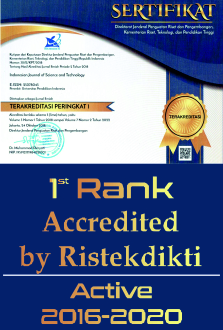The Ship’s Propeller Rotation Threshold for Coral Reef Ecosystems Based on Sediment Rate Indicators: Literature Review with Bibliometric Analysis and Experiments
Abstract
Keywords
Full Text:
PDFReferences
Al Husaeni, D. F., and Nandiyanto, A. B. D. (2022). Bibliometric using vosviewer with publish or perish (using Google Scholar data): From step-by-step processing for users to the practical examples in the analysis of digital learning articles in pre and post covid-19 pandemic. ASEAN Journal of Science and Engineering, 2(1), 19–46.
Bainbridge, Z., Lewis, S., Bartley, R., Fabricius, K., Collier, C., Waterhouse, J., Garzon-Garcia, A., Robson, B., Burton, J., Wenger, A., and Brodie, J. (2018). Fine sediment and particulate organic matter: A review and case study on ridge-to-reef transport, transformations, fates, and impacts on marine ecosystems. Marine Pollution Bulletin, 135, 1205–1220.
Bartley, R., Bainbridge, Z. T., Lewis, S. E., Kroon, F. J., Wilkinson, S. N., Brodie, J. E., and Silburn, D. M. (2014). Relating sediment impacts on coral reefs to watershed sources, processes and management: A review. Science of the Total Environment, 468–469, 1138–1153.
Ceccarelli, D. M., Lestari, A. P., Rudyanto, and White, A. T. (2022). Emerging marine protected areas of eastern Indonesia: Coral reef trends and priorities for management. Marine Policy, 141, 105091.
Cui, Y., Lam, W. H., Robinson, D., and Hamill, G. (2020). Temporal and spatial scour caused by external and internal counter-rotating twin-propellers using Acoustic Doppler Velocimetry. Applied Ocean Research, 97, 102093.
Cui, Y., Lam, W. H., Zhang, T., Sun, C., and Hamill, G. (2019). Scour induced by single and twin propeller jets. Water (Switzerland), 11(5), 1097.
Cui, Y., Lam, W. H., Zhang, T., Sun, C., Robinson, D., and Hamill, G. (2019a). Temporal model for ship twin-propeller jet induced sandbed scour. Journal of Marine Science and Engineering, 7(10), 339.
Curulli, G., Llull, T., Penna, N., Mujal-Colilles, A., Gironella, X., Sánchez-Arcilla, A., and Gaudio, R. (2022). Relationship between eroded volume and main scour hole dimensions near quay walls caused by internal counter-rotating twin-propellers. Ocean Engineering, 259, 111744.
Curulli, G., Penna, N., and Gaudio, R. (2023). Improved formulation for the geometric characteristics of the scour hole and deposition mound caused by a rotating propeller jet on a mobile bed. Ocean Engineering, 267, 113175.
Duckworth, A., Giofre, N., and Jones, R. (2017). Coral morphology and sedimentation. Marine Pollution Bulletin, 125(1–2), 289–300.
Dutra, L. X. C., Kikuchi, R. K. P., and Leão, Z. M. A. N. (2006). Effects of sediment accumulation on reef corals from Abrolhos, Bahia ,Brazil. Journal of Coastal Research, 22, 633–638.
Erftemeijer, P. L. A., Riegl, B., Hoeksema, B. W., and Todd, P. A. (2012). Environmental impacts of dredging and other sediment disturbances on corals: A review. Marine Pollution Bulletin, 64(9), 1737–1765.
Fabricius, K. E. (2005). Effects of terrestrial runoff on the ecology of corals and coral reefs: Review and synthesis. Marine Pollution Bulletin, 50(2), 125–146.
Fiandini, M., Bayu, A., Nandiyanto, D., Fitria, D., Husaeni, A., Novia, D., and Mushiban, M. (2024). How to calculate statistics for significant difference test using SPSS: Understanding students comprehension on the concept of steam engines as power plant how to calculate statistics for significant difference test using SPSS. Indonesian Journal of Science and Technology, 9(1), 45–108.
Flynn, R. L., and Forrester, G. E. (2019). Boat anchoring contributes substantially to coral reef degradation in the British Virgin Islands. PeerJ, 7, e7010.
Forrester, G. E. (2020). The influence of boat moorings on anchoring and potential anchor damage to coral reefs. Ocean and Coastal Management, 198, 105354.
Guarnieri, A., Saremi, S., Pedroncini, A., Jensen, J. H., Torretta, S., Vaccari, M., and Vincenzi, C. (2021). Effects of marine traffic on sediment erosion and accumulation in ports: A new model-based methodology. Ocean Science, 17(2), 411–430.
Hong, J.-H., Chiew, Y.-M., Hsieh, S.-C., Cheng, N.-S., and Yeh, P.-H. (2016). Propeller jet–induced suspended-sediment concentration. Journal of Hydraulic Engineering, 142(4), 04015064.
Kadir, A., Subagio, A., Kartikasari, D., Sadiah, S., Himawan, S., Virliani, P., Kusuma, Y. F., Satria, E., Putra, A., and Eritha, F. N. (2023). The effect of the external counter rotating for the water flow velocity profile of twin propeller system. Journal of Applied Science and Engineering, 27(8), 2945–2955.
Kaidi, S., Smaoui, H., and Sergent, P. (2021). Numerical investigation of the inland transport impact on the bed erosion and transport of suspended sediment: Propulsive system and confinement effect. Journal of Marine Science and Engineering, 9(7), 746.
Kozerski, H. P. (2002). Determination of areal sedimentation rates in rivers by using plate sediment trap measurements and flow velocity - Settling flux relationship. Water Research, 36(12), 2983–2990.
Li, X. bao, Huang, H., Lian, J. sheng, Liu, S., Huang, L. min, and Yang, J. hui. (2013). Spatial and temporal variations in sediment accumulation and their impacts on coral communities in the Sanya Coral Reef Reserve, Hainan, China. Deep-Sea Research Part II: Topical Studies in Oceanography, 96, 88–96.
Loiola, M., Oliveira, M. D. M., and Kikuchi, R. K. P. (2013). Tolerance of Brazilian brain coral Mussismilia braziliensis to sediment and organic matter inputs. Marine Pollution Bulletin, 77(1–2), 55–62.
Loya, Y. (1976). Effects of water turbidity and sedimentation on the community structure of puerto rican corals. Bulletin of Marine Science, 26(4), 450–466.
Minton, D., Burdick, D., and Brown, V. (2022). Changes in coral reef community structure along a sediment gradient in Fouha Bay, Guam. Marine Pollution Bulletin, 181, 113816.
Nandiyanto, A. B. D., and Al Husaeni, D. F. (2021). A bibliometric analysis of materials research in Indonesian journal using VOSviewer. Journal of Engineering Research (Kuwait), 9, 1–16.
Nguyen, T. H., Kieu-Le, T. C., Tang, F. H. M., and Maggi, F. (2022). Controlling factors of microplastic fibre settling through a water column. Science of the Total Environment, 838(December 2021), 156011.
Penna, N., D’Alessandro, F., Gaudio, R., and Tomasicchio, G. R. (2019). Three-dimensional analysis of local scouring induced by a rotating ship propeller. Ocean Engineering, 188, 106294.
Razak, T. B., Boström-Einarsson, L., Alisa, C. A. G., Vida, R. T., and Lamont, T. A. (2022). Coral reef restoration in Indonesia: A review of policies and projects. Marine Policy, 137, 104940.
Rogers, C. S. (1990). Responses of coral reefs and reef organisms to sedimentation. Marine Ecology Progress Series Oldendorf, 62(1), 185-202.
Rogers, Caroline S. (1990). Responses of coral reefs and reef organisms to sedimentation. Marine Ecology Progress Series, 62, 185–202.
Ryan, K. E., Walsh, J. P., Corbett, D. R., and Winter, A. (2008). A record of recent change in terrestrial sedimentation in a coral-reef environment, La Parguera, Puerto Rico: A response to coastal development? Marine Pollution Bulletin, 56(6), 1177–1183.
Schlaefer, J. A., Tebbett, S. B., Bowden, C. L., Collins, W. P., Duce, S., Hemingson, C. R., Huertas, V., Mihalitsis, M., Morais, J., Morais, R. A., Siqueira, A. C., Streit, R. P., Swan, S., Valenzuela, J., and Bellwood, D. R. (2022). A snapshot of sediment dynamics on an inshore coral reef. Marine Environmental Research, 181, 105763.
Scully, B., and Young, D. (2021). Evaluating the underkeel clearance of historic vessel transits in the southwest pass of the mississippi river. Journal of Waterway, Port, Coastal, and Ocean Engineering, 147(5), 1–13.
Sethulekshmi, S., Kalbar, P., and Shriwastav, A. (2023). A unified modelling framework for type I (discrete) settling and rising of microplastics in primary sedimentation tanks. Journal of Environmental Management, 334, 117444.
Soegoto, H., Soegoto, E. S., Luckyardi, S., and Rafdhi, A. A. (2022). A bibliometric analysis of management bioenergy research using vosviewer application. Indonesian Journal of Science and Technology, 7(1), 89–104.
Stead, J. L., and Bond, T. (2023). The impact of riverine particles on the vertical velocities of large microplastics. Science of the Total Environment, 896, 165339.
Tan, R. İ., and Yüksel, Y. (2018). Seabed scour induced by a propeller jet. Ocean Engineering, 160, 132–142.
Van Rijn, L. C. (2007). Unified view of sediment transport by currents and waves. III: Graded beds. Journal of Hydraulic Engineering, 133(7), 761-775.
Victor, S., Neth, L., Golbuu, Y., Wolanski, E., and Richmond, R. H. (2006). Sedimentation in mangroves and coral reefs in a wet tropical island, Pohnpei, Micronesia. Estuarine, Coastal and Shelf Science, 66(3–4), 409–416.
Weber, M., De Beer, D., Lott, C., Polerecky, L., Kohls, K., Abed, R. M. M., Ferdelman, T. G., and Fabricius, K. E. (2012). Mechanisms of damage to corals exposed to sedimentation. Proceedings of the National Academy of Sciences of the United States of America, 109(24), E1558-E1567.
Yang, G., Yu, Z., Baki, A. B. M., Yao, W., Ross, M., Chi, W., and Zhang, W. (2023). Settling behaviors of microplastic disks in water. Marine Pollution Bulletin, 188, 114657.
Ye, Z., Cheng, L., and Zang, Z. (2011). Experimental study of erosion threshold of reconstituted sediments. Proceedings of the International Conference on Offshore Mechanics and Arctic Engineering - OMAE, 7, 973–983.
Ytreberg, E., Åström, S., and Fridell, E. (2021). Valuating environmental impacts from ship emissions–The marine perspective. Journal of Environmental Management, 282, 111958.
Yu, Z., Yang, G., and Zhang, W. (2022). A new model for the terminal settling velocity of microplastics. Marine Pollution Bulletin, 176, 113449.
Zhang, J., Ji, C., Liu, G., Zhang, Q., and Xing, E. (2023). Settling processes of cylindrical microplastics in quiescent water: A fully resolved numerical simulation study. Marine Pollution Bulletin, 194(PB), 115438.
Zhu, X., Zeng, Y. H., and Huai, W. X. (2017). Settling velocity of non-spherical hydrochorous seeds. Advances in Water Resources, 103, 99–107.
DOI: https://doi.org/10.17509/ijost.v9i2.67894
Refbacks
- There are currently no refbacks.
Copyright (c) 2024 Universitas Pendidikan Indonesia

This work is licensed under a Creative Commons Attribution-ShareAlike 4.0 International License.
Indonesian Journal of Science and Technology is published by UPI.
View My Stats





















